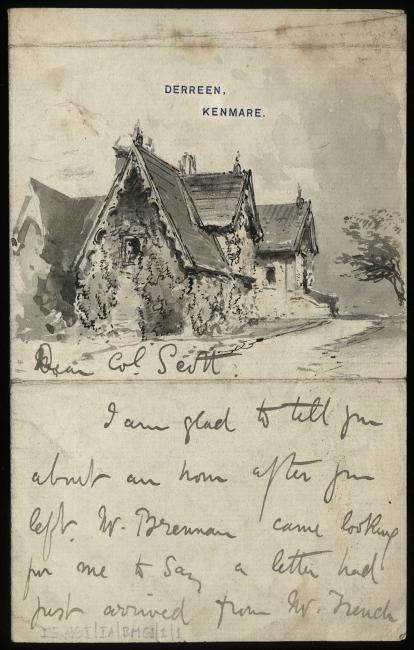
William Bingham McGuinness
It was while completing his architectural apprenticeship in Dublin that William Bingham McGuinness (1849-1928) first began attending painting classes at the Royal Hibernian Academy. This was to be a defining diversion for the young architect, drawing him away from his formal studies, and confirming his desire to devote himself entirely to painting. His early professional training and skilled draughtsmanship remained in evidence in many of his paintings. From tranquil rural Irish villages to bustling French city streets, McGuinness’s work reveals an artist with an appreciation for architectural design and its potential for narrative impact in art.
The Centre for the Study of Irish Art is fortunate to have an illustrated letter written by Bingham McGuinness in which the seemingly inextricable link between one’s environment and experience is beautifully captured.
Sketching Kenmare
Written to his friend Colonel Scott, the undated letter speaks of Bingham McGuinness’s arrival in Derreen, Kenmare, County Kerry to undertake sketches of the local area. Staying with the Brennan family, he informs Scott how a letter from a mutual friend, Mr. French, to his hosts, advising them to give Bingham McGuinness every assistance during his stay, has worked to make him very comfortable. It seems that Bingham McGuinness was offered rooms in a local cottage, but appears unhappy with the dwelling, describing it as
‘very damp at present and fowly … I certainly would not like it as a residence.’
In addition to his narrative text, McGuinness has also illustrated his letter, including a pen and wash sketch of a rural dwelling on the first page. Echoing many of his well-known watercolour paintings of rural Ireland, such as The Homestead, or The Kerry Cottage, this simple illustration is full of texture and well-observed detail. He captures the delicate wooden awning of the roof, and what appears to be a mossy growth along a gable wall. Was this the cottage he had dismissed for his accommodation or the more hospitable Brennan residence where his comfort was being well attended?
It is of note that he chose to illustrate this architectural feature, when other artists might have chosen a character study of a local personality or event instead. Whilst Bingham McGuinness remained an artist until his death in 1928, exhibiting over 150 works at the Royal Hibernian Academy between 1866-1926, and others at the Royal Academy London, his early architectural training remained in evidence throughout, having put in place a firm foundation for the artist he became.

By William Bingham McGuinness
Watercolour, 26.5 x 36.5cm
Sold at private auction, 2018

The Tower of St Romain Church, Rouen, from Rue Horlogue
By William Bingham McGuinness, 1878
Watercolour with white highlights on paper, 50.5 x 34.7 cm
NGI.19398
Credit
Claire Doohan, Mahon Project Archivist
Published online: 2022